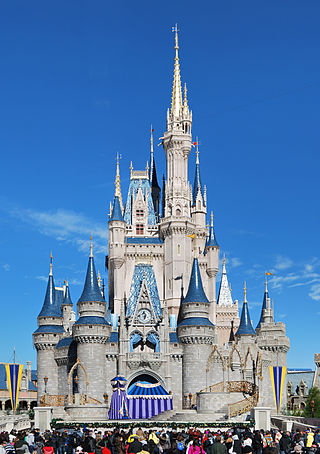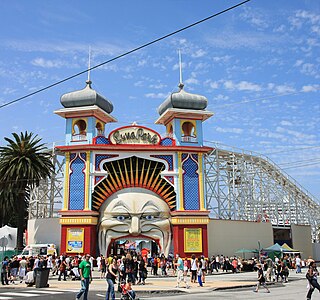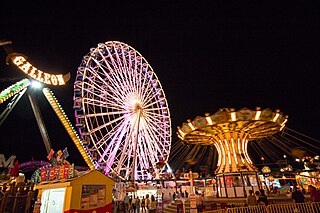
An amusement park is a park that features various attractions, such as rides and games, as well as other events for entertainment purposes. A theme park is a type of amusement park that bases its structures and attractions around a central theme, often featuring multiple areas with different themes. Unlike temporary and mobile funfairs and carnivals, amusement parks are stationary and built for long-lasting operation. They are more elaborate than city parks and playgrounds, usually providing attractions that cater to a variety of age groups. While amusement parks often contain themed areas, theme parks place a heavier focus with more intricately-designed themes that revolve around a particular subject or group of subjects.

A roller coaster inversion is a roller coaster element in which the track turns riders upside-down and then returns them to an upright position. Early forms of inversions were circular in nature and date back to 1848 on the Centrifugal railway in Paris. These vertical loops produced massive g-force that was often dangerous to riders. As a result, the element eventually became non-existent with the last rides to feature the looping inversions being dismantled during the Great Depression. In 1975, designers from Arrow Development created the corkscrew, reviving interest in the inversion during the modern age of steel roller coasters. Elements have since evolved from simple corkscrews and vertical loops to more complex inversions such as Immelmann loops and cobra rolls. The Smiler at Alton Towers holds the world record for the number of inversions on a roller coaster with 14.

Intamin Amusement Rides is a design and manufacturing company in Schaan, Liechtenstein, best-known for designing and constructing thrill rides and roller coasters at dozens of international theme parks, amusement parks and other establishments. The Intamin brand name is a syllabic abbreviation for "international amusement installations". The company has corporate offices across the world, including three in Europe, three in Asia, and two in the United States.

Canobie Lake Park is an amusement park in Salem, New Hampshire, located about 31 miles (50 km) north of Boston. It was founded as a trolley park on the shore of Canobie Lake in 1902. Three local families currently run the park, which draws visitors from throughout the New England and Mid-Atlantic regions. Canobie Lake Park's age and history inspired author Stephen King to use rides and elements from the park in his Joyland novel. It is one of only thirteen trolley parks still operating in the United States as of 2021.

Luna Park Melbourne is a historic amusement park located on the foreshore of Port Phillip Bay in St Kilda, Melbourne, Victoria. It opened on 13 December 1912, with a formal opening a week later, and has been operating almost continuously ever since.

Morey’s Piers & Beachfront Waterparks is a seaside amusement park located on The Wildwoods' boardwalk in Wildwood and North Wildwood, New Jersey. The park has been family owned and operated since 1969 and is currently run by 2nd generation Morey Brothers, Will and Jack. Morey’s Piers has more than 100 rides and attractions across its three amusement piers and two beachfront waterparks.

Lake Winnepesaukah, commonly known as Lake Winnie, is an amusement park located in Rossville, Georgia, on the south of Chattanooga, Tennessee. Carl and Minette Dixon opened the park to over 5,000 guests on June 1, 1925. They named it after the Native American word Winnepesaukah, meaning "bountiful waters" or "beautiful lake of the highlands". The park originally featured the largest swimming pool in the southeastern United States, which debuted in 1926 and was later removed. Its Boat Chute attraction, designed by Carl Dixon and opened in 1927, is the oldest mill chute water ride of its kind still operating in the United States.
This is a summary of notable incidents that have taken place at various SeaWorld Parks & Entertainment-owned amusement parks, water parks or theme parks. This list is not intended to be a comprehensive list of every such event, but only those that have a significant impact on the parks or park operations, or are otherwise significantly newsworthy.
The following article is a summary of notable incidents at the amusement parks and water parks that are operated by Six Flags Entertainment Corporation. In some cases, these incidents occurred while the park was under different management or ownership.
This is a summary of notable incidents that have taken place at various Universal-owned theme parks, amusement parks, or water parks. This list is not intended to be a comprehensive list of every such event, but only those that have a significant impact on the parks or park operations, or are otherwise significantly newsworthy.
This is a summary of notable incidents that have taken place at various European amusement parks, water parks, or theme parks. This list is not intended to be a comprehensive list of every such event, but only those that have a significant impact on the parks or park owners, or are otherwise significantly newsworthy.
This is a summary of notable incidents that have taken place at amusement parks, water parks, or theme parks operated by Premier Parks, LLC. This list is not intended to be a comprehensive list of every such event, but only those that have a significant impact on the parks or park operations, or are otherwise significantly newsworthy.

Sea Lion Park was a 16-acre (65,000 m2) amusement park started in 1895 on Coney Island by Paul Boyton. He fenced the property and charged admission, the park becoming the first enclosed and permanent amusement park in North America. Up until the establishment of this park, amusement areas around the country consisted of pay-as-you-go concessions. In 1903, Sea Lion Park was replaced by Luna Park.

The Pleasure Beach Great Yarmouth is an amusement park located in the seaside resort town of Great Yarmouth, Norfolk, on the English east coast. It opened in 1909. The largest and most popular ride at the park is the wooden Roller Coaster which opened in 1932. There are also around twenty four other large rides at the park, as well as children's entertainment, amusement arcades, catering facilities, sweet shops and ice cream parlours.

Gillian's Wonderland Pier is a historic amusement park founded in 1929 by David Gillian, who first came to Ocean City in 1914. It is located near the beginning of the commercial boardwalk on 6th street. Gillians is generally considered to be an institution of Ocean City, with grand openings and pre-season sales for the location historically having drawn crowds multiple blocks long, and employs many local youths during the summer, and in more recent years, many Eastern European workers.

Pleasure Beach Resort, formerly known as Blackpool Pleasure Beach, is an amusement park situated on Blackpool's South Shore, in the county of Lancashire, North West England. The park was founded in 1896 by A. W. G. Bean and his partner John Outhwaite. The current managing director is Amanda Thompson.











